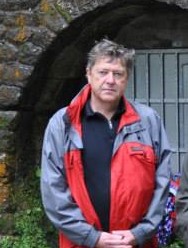
Mitja Ferenc (21 March 1960) is a Slovenian historian, educator, and author.
Ferenc was born in Ljubljana, the son of renowned historian and partisan Tone Ferenc. He graduated from modern history at the University of Ljubljana in 1985. Since 2000, he has researched the graves of people killed on Slovenian territory by the Yugoslav Communist regime after the end of World War II in the Bleiburg repatriations. [1]
Between 2002–04, Ferenc was a member of the Commission on Concealed Mass Graves in Slovenia established by the Slovenian Government to document the 581 mass graves [2] from Communist era found in Slovenia. [3]
Ferenc contributed to the European Public Hearing on "Crimes Committed by Totalitarian Regimes" organised by Slovenian Presidency of the Council of the European Union (January–June 2008) and the European Commission. His work was featured in the chapter "Secret World War Two Mass Graves in Slovenia". [4]
Ferenc teaches history at the University of Ljubljana. He has written several books on the history of the Gottschee German community.[ citation needed ]